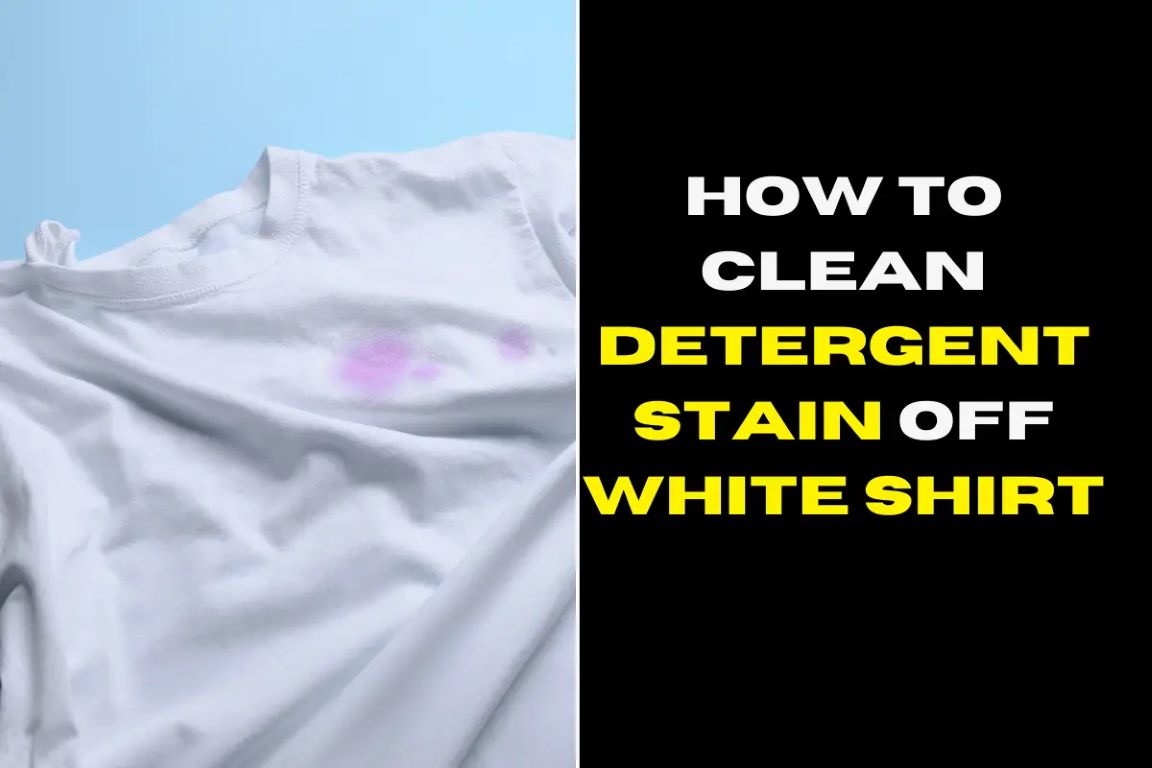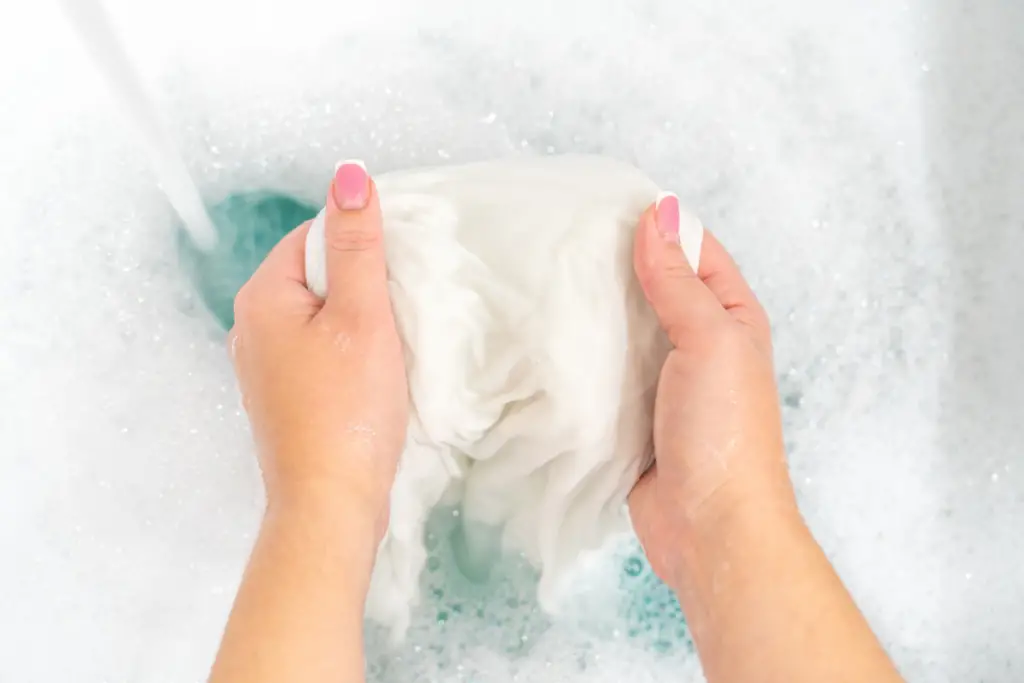
There’s nothing quite as frustrating as pulling your crisp, white shirt from the laundry only to find unsightly detergent stains spoiling its pristine beauty. What should have been a routine washing cycle becomes a daunting chore of removing the stain.
But worry not – even the stubborn detergent stains can be defeated, and your white shirt can regain its brightness.
This post will introduce you to practical and efficient ways to remove detergent stains from your white shirts. The knowledge of proper stain removal techniques in this post can save your favorite garments from being permanently stained and help them last longer.
Tips for Preventing Detergent Stains
Preventing detergent stains is far easier than trying to remove them. Here are some practical tips to keep your white shirts spotless and radiant.
1. Correct detergent dosage
One of the primary reasons for detergent stains is using too much detergent. Overloading your washing machine with detergent does not translate into cleaner clothes. In fact, it can leave residue behind, causing visible stains, especially on white shirts. Always follow the manufacturer’s guidelines on detergent dosage.
2. Choose the right detergent
Not all detergents are created equal. Some may leave a residue on your clothes, causing visible stains. Opt for a high-efficiency (HE) detergent, particularly if you have a front-loading or high-efficiency top-loading washer. HE detergents produce fewer suds, reducing the risk of leftover soap residue.
3. Dissolve detergent properly
Dissolve the powdered detergent in water before adding your clothes to the machine. This practice ensures the detergent disperses evenly, reducing the chances of it depositing on your garments.
4. Do not overload the washer
A crowded washer doesn’t allow the clothes enough space to agitate freely. This overcrowding can prevent the detergent from distributing evenly, increasing the likelihood of detergent stains.
5. Use cold water for rinsing
Rinsing your clothes in cold water can help prevent detergent from leaving a residue. Warm water can cause some detergents to redeposit on your clothes, causing stains.
6. Opt for Liquid Detergent or pods
Liquid detergent and pods tend to dissolve better than powder, especially in lower temperatures. It might be worth switching if you’ve had issues with detergent stains from powder.
Step-By-Step Guide on How to Remove Detergent Stains from Your White Shirt
Step 1: Identify the stain
The first step is to identify the detergent stain correctly. These stains often appear bluish or whitish and can feel stiff to the touch.
Step 2: Soak the shirt in vinegar
Fill a tub or sink with lukewarm water and add a half cup of distilled white vinegar. Soak the stained shirt in this mixture for at least 30 minutes. The vinegar helps to dissolve the alkaline detergent stains.
Step 3: Rinse
After soaking, rinse the shirt thoroughly under running water. This process should help to remove a substantial amount of the stain.
Step 4: Pre-treat the stain
Apply a few drops of liquid dish soap or laundry detergent directly to the remaining stain. Gently rub it in using your fingers or a soft cloth. Let it sit for 15 minutes. These substances can help break down any remaining detergent residue.
Step 5: Wash the shirt
Wash the shirt as you normally would, following the care instructions on its label. Make sure to use the appropriate amount of detergent so you don’t recreate the same problem.
Step 6: Air dry
After washing, resist the temptation to throw the shirt in the dryer. Heat can set any remaining stain, making removing it even more challenging. Instead, air-dry your shirt in a shaded, well-ventilated area.
Step 7: Inspect
Once the shirt is dry, inspect it for any remaining stains. If you still see the stain, repeat the steps above. Persistence is key here.
7 Common Mistakes to Avoid when Trying to Remove Stains

Here are some common mistakes people often make when trying to remove stains from their clothing:
1. Rubbing the stain too hard
Rubbing a stain vigorously can actually push it further into the fabric, making it harder to remove. Moreover, aggressive rubbing can damage the fabric fibers. Instead, gently blot or rub the stain.
2. Using hot water
Hot water can set certain stains, making them nearly impossible to remove. Unless you’re sure that hot water is appropriate for the type of stain and fabric you’re dealing with, it’s safer to stick with cold or lukewarm water.
3. Not pre-treating stains
One common mistake is to throw a stained garment straight into the wash without pre-treating the stain. Pre-treating helps to break down the stain before washing, making it easier for the washing process to remove it completely.
4. Using too much stain remover
Just as with detergent, more isn’t necessarily better when it comes to stain removers. Too much can leave a residue that may not rinse completely in the wash.
5. Not checking the garment after washing
It’s essential to check your garment for stains after washing but before drying. If a stain didn’t come out completely in the wash, drying it will set the stain and make it much harder to remove.
6. Using bleach incorrectly
While bleach can effectively treat stains on white clothes, it must be used correctly. Bleach should be diluted and never used on silk, wool, or spandex. Moreover, overusing bleach can weaken fabric fibers.
7. Ignoring fabric care labels
Fabric care labels provide essential information on how to clean your clothes properly. Ignoring these instructions can lead to ruined garments and stubborn stains.
7 Additional Tips for Keeping White Shirts Bright
1. Separate whites and colors
One of the cardinal rules of laundry is always to separate white from colored clothing. This prevents color transfer, which can dull the brightness of your white shirts.
2. Use a whitening agent
There are products specifically designed to enhance the whiteness of your clothes. You can add a safe whitening agent (like oxygen bleach or baking soda) to your wash to maintain the brightness of your white shirts.
3. Lemon juice soak
Lemon juice is a natural bleaching agent. Soaking your white shirts in a mixture of lemon juice and warm water for an hour before washing can help to brighten them. However, remember to rinse the shirts thoroughly before exposing them to sunlight, as lemon juice can cause damage in sunlight.
4. Rinse thoroughly
Make sure to rinse your white shirts thoroughly. Any detergent or soap left in the fabric can make it look dull.
5. Dry Properly
Drying white shirts in the sun can naturally bleach and brighten them. However, too much sunlight can weaken the fibers, so don’t leave your shirts in the sun for too long.
6. Use the right amount of detergent
As mentioned earlier, using too much detergent can leave a residue that dulls the brightness of your white shirts. Use the recommended amount of good-quality detergent.
7. Regular maintenance
It’s easier to keep a white shirt bright than to try to brighten it once it’s become dull. Regular maintenance, like immediate stain treatment and proper washing techniques, can help to keep your white shirts looking their best.
Frequently Asked Questions
Can you get rid of detergent stains on clothes?
Yes, detergent stains on clothes can be effectively removed by employing appropriate washing techniques and stain removal methods.
Why did my detergent stain my white shirt?
Your detergent stained your white shirt because an excessive amount was used or it was not fully dissolved or rinsed out, leaving a visible residue on the fabric.
Does vinegar remove detergent from clothes?
Yes, vinegar can help remove detergent residue from clothes due to its acidity, which effectively breaks down the alkaline detergent.
Final Words
With these practical and effective tips at your fingertips, you’re now well-equipped to deal with pesky detergent stains that can mar the brilliance of your white shirts.
Laundry isn’t just a chore but a skill that, when mastered, can extend the life of your favorite pieces and keep them looking their best.
Happy washing, and here’s to maintaining the vibrancy and beauty of your white shirts for years to come!






